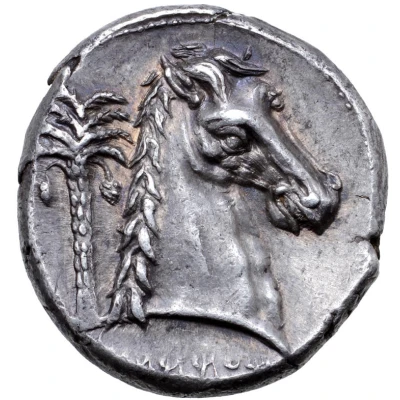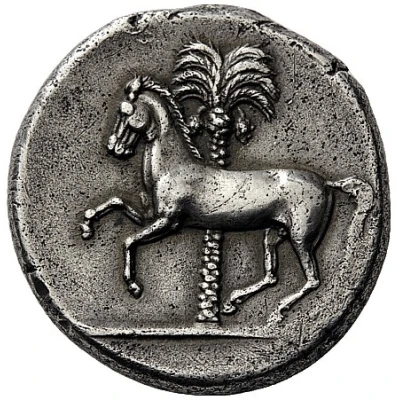


© Roma Numismatics Limited
Tetradrachm 320 BC - 300 BC
| Silver | 17.15 g | 27 mm |
| Issuer | Uncertain Punic mint (Carthaginian Empire) |
|---|---|
| Type | Standard circulation coin |
| Years | 320 BC - 300 BC |
| Value | Tetradrachm (20) |
| Currency | Litra |
| Composition | Silver |
| Weight | 17.15 g |
| Diameter | 27 mm |
| Shape | Round (irregular) |
| Technique | Hammered |
| Orientation | Variable alignment ↺ |
| Demonetized | Yes |
| Updated | 2024-10-09 |
| Numista | N#196073 |
|---|---|
| Rarity index | 100% |
Reverse
Horse's head right, palm tree with date clusters behind; S'MMHNT in punic script in exergue.
Translation: People of the Camp
Comment
The Siculo-Punic tetradrachms were issued for financing of Carthaginian military campaigns in Sicily. From the late fifth century BC, the coins combined traditional Carthaginian and Greek Sicilian city states designs. The styles of these coins varied considerably from those bearing a distinctly 'Punic' appearance, to those that were very fair emulations of the work of Syracusan masters.Interesting fact
The Tetradrachm coin from the Carthaginian Empire was used as a form of currency in the ancient Mediterranean world, and its design was influenced by the Greek coinage of the time. The obverse side of the coin typically featured a portrait of a deity, while the reverse side featured a symbol of the Carthaginian Empire, such as a palm tree or a horse. The coin was made of silver and weighed around 17.15 grams, making it a significant unit of currency in the ancient economy. Despite being produced by an uncertain Punic mint, the Tetradrachm coin remains a valuable piece of history for numismatists and collectors today.



